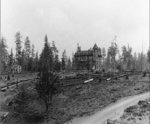
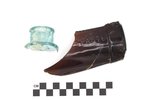
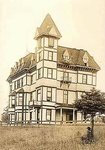
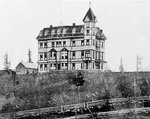
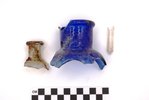
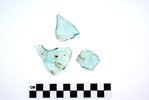
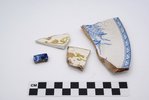
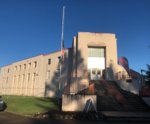
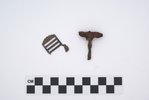
A plan to put a parking lot near Centralia’s National Guard Armory at Seminary Hill last summer revealed a treasure trove of archaeological artifacts that had long been buried beneath the sediments of time.
As crews began to dig in preparation for the new armory parking lot, bits and pieces of Centralia’s history slowly began to reveal themselves. Once workers realized what they were looking at, construction was stopped in order to follow strict archaeological policy. As it turns out, what the parking lot dig, and then the strict archeological dig, uncovered was a heap of history dating all the way back to Centralia’s origins, including tea cups and other ceramics, writing materials believed to be from Grace Seminary school, pieces of medical equipment from the old Centralia General Hospital and of course the iron and bricks that formed the historic buildings.
“During our construction project archeological artifacts were uncovered which meant that we stopped construction because those cultural resource deposits are considered resources of the state,” explained Elizabeth Murphy of the Washington Military Department Natural and Cultural Resources division.
Murphy noted that in accordance with the National Historic Preservation Act, the artifacts were collected and sent off to the State Historic Preservation Department in order to determine their significance. Crews also collaborated with the Tribal Historic Preservation Officer of the Chehalis Tribe in order to ensure that no artifacts or areas of Native American significance were present.
Once it was confirmed that all of the artifacts close to the surface had been located and extracted, the parking lot project was allowed to continue, “Which essentially capped the resource from future potential disturbance,” explained Murphy.
Murphy noted that the artifacts were sent to the Burke Museum in Seattle for curation and study. She expects a formal report to become available to the public within the next month. Additionally, the most interesting artifacts will eventually be brought home to the Twin Cities in order to be displayed at the Lewis County Historical Museum.
The Grace Seminary school was built more than 100 years ago and became the namesake of Seminary Hill. The land that the school was built on was donated in the late 1800s by the founders of Centerville themselves, George and Mary Jane Washington.
Brian Mittge, president of Friends of the Seminary HIll Natural Area, noted in an email to The Chronicle that, “Interestingly, another African-American couple, the Bryans, were the original owners of the land on which the seminary was built, and were also donors who helped make the seminary a reality.”
Murphy said that the discovery of the Seminary Hill artifacts has helped researchers piece together a more complete timeline of activity on the old hill that overlooks downtown Centralia. She noted that the Grace Seminary School was a three-story “large gothic wooden structure from which Seminary Hill got its name. Because it sat there on the hill very prominently, which at that time was clear cut, so passing trains could see it very clear up on the hill.”
Eventually hard times forced the old school to shut down and after sitting vacant for a few years the building was converted to Centraila’s general hospital.
“Our researchers found that as a very fascinating period for the building,” said Murphy, who noted that the era was marked by abysmal sanitary practices that were common of the time period just before big changes in surgical practices were implemented nationwide.
“Our researchers associated the shutdown of Centralia General Hospital with that nationwide change in medical practices and the construction of the new facility in town,” said Murphy.
Murphy added that oral accounts of the hill’s history have indicated that the old building was torn down, and possibly set on fire, in order to make room for the incoming armory that was later built in its stead. However, Murphy says that the archaeological record does not seem to support that version of events.
“Supposedly it was taken down because it was a fire hazard. So if you can imagine an abandoned, three story, gothic building … It was probably like a haunted house or something,” said Murphy.
Murphy said the assortment of artifacts was varied, although some base materials showed up again and again.
“Specifically, it was largely fragments of white ware, so kind of ceramic fragments. In their reports they refer to it as institutional white ware, which could have been associated with either the seminary or the hospital,” said Murphy. “A lot of pieces of glass. A lot of pieces of the building itself, many of which were not that interesting if you can just imagine redundant pieces of brick and iron. There were bottles associated with the hospital and they were actually sent to the University of Idaho for study,” said Murphy.
Murphy said the researchers working with the artifacts are hoping to learn more about day-to-day life of the people on Seminary Hill including their diet, medicinal practices and the academic and artistic pursuits of the school.
“I think one of the best outcomes is that we really had a thorough archival process of the grounds. A much more thorough understanding than we did previously,” said Murphy. “I think that this really speaks to the armory wanting to be involved in the community.”
Murphy added that the newfound information will be shared with the public in a variety of ways, including the report, the artifacts at the museum, and informational signage on Seminary Hill itself.
“We will be creating a public version (of the report) that we can distribute. That means we’ll essentially take out any of the sensitive information as to where exactly artifacts were found in order to protect them,” said Murphy, who spoke about the findings at the Friends of Seminary Hill meeting on Saturday. “We’re actually letting the community drive us and tell us what they want.”
Mittge says he is excited to see where Centralia’s latest historical finding will lead. He noted that several options for informational signage are being considered, including posting a series of displays around the Seminary Hill Natural Area. Another option would place signs in downtown Centralia, possibly at the train station, so that people can look up at the prominent hill while they learn about its history.
“The military department is really working to spread the word about this discovery and as part of that they want to work with the Friends of the Seminary Hill Natural Area in order to work this discovery into the story that we’re tyring to tell about Seminary Hill,” said Mittge. “If people want to get involved we’d love to have those extra voices.”
Mittge said the Friends of Seminary Hill will likely meet in the next month in order to continue drawing up plans for future displays. To get involved locally contact Mittge by email at brianmittge@hotmail.com.
Anyone with questions or input about the Seminary Hill artifacts can contact Murphy by email at Elizabeth.murphy@mil.wa.gov.